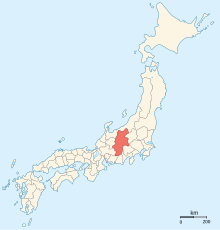Shio no Michi

Shio no Michi (
Stations of the Chikuni Kaidō
[edit]On the Echigo Province side of the route, it was called the Itoigawa Kaidō, but on the Shinano Province side, it was called Chikuni Kaidō. The Sawado-juku and Sano-juku pair and the Ida-juku and Imori-juku pair each essentially functioned as one post station.
Niigata Prefecture
[edit]- 1. Itoigawa-juku (
糸魚川 宿 ) (Itoigawa) - 2. Yamaguchi-juku (
山口 宿 ) (Itoigawa)
Nagano Prefecture
[edit]- 3. Ōami-juku (
大網 宿 ) (Otari) - 4. Kuruma-juku (
来馬 宿 ) (Otari) - 5. Chikuni-juku (
千 国 宿 ) (Otari) - 6. Shiojima Shinden-juku (
塩 島新田 宿 ) (Hakuba) - 7. Iida-juku (
飯田 宿 ) and Iimori-juku (飯森 宿 ) (Hakuba) - 8. Sawado-juku (
沢 度 宿 ) and Sano-juku (佐 野宿 ) (Hakuba) - 9. Uminokuchi-juku (
海ノ口 宿 ) (Ōmachi) - 10. Ōmachi-juku (
大町 宿 ) (Ōmachi) - 11. Ikeda-juku (
池田 宿 ) (Ikeda) - 12. Hotaka-juku (
保高 宿 ) (Azumino) - 13. Nariai Shinden-juku (
成 相 新田宿 ) (Azumino) - 14. Matsumoto-juku (
松本 宿 ) (Matsumoto)
Stations of the Sanshū Kaidō
[edit]

The salt was initially carried from Mikawa Bay by boats traveling up the Yahagi River and its tributary, the Tomoe River. From Toyota, it was carried by horse, marking the start of the Sanshū Kaidō.
Aichi Prefecture
[edit]- 1. Okazaki-shuku (
岡崎 宿 ) (Okazaki) (also part of the Tōkaidō) - 2. Kugyūdaira-juku (
九久平 宿 ) (Toyota) - 3. Asuke-juku (
足助 宿 ) (Toyota) - 4. Busetsu-juku (
武節 宿 ) (Toyota)
Nagano Prefecture
[edit]- 5. Neba-juku (
根羽 宿 ) (Neba) - 6. Hiraya-juku (
平谷 宿 ) (Hiraya) - 7. Namiai-juku (
浪 合宿 ) (Namiai) - 8. Komaba-juku (
駒場 宿 ) (Achi) - 9. Iida-juku (
飯田 宿 ) (Iida) - 10. Ichida-juku (
市田 宿 ) (Takamori) - 11. Ōjima-juku (
大島 宿 ) (Matsukawa) - 12. Katabora-juku (
片桐 宿 ) (Matsukawa) - 13. Iijima-juku (
飯島 宿 ) (Iijima) - 14. Akazu Uwabu-juku (
赤須 上 穂 宿 ) (Komagane) - 15. Miyada-juku (
宮田 宿 ) (Miyada) - 16. Inabe-juku (
伊那部 宿 ) (Ina) - 17. Matsujima-juku (
松島 宿 ) (Minowa) - 18. Miyagi-juku (
宮木 宿 ) (Tatsuno) - 19. Ono-juku (
小 野宿 ) (Shiojiri) - 20. Shiojiri-shuku (
塩尻 宿 ) (Shiojiri) (also part of the Nakasendō)
See also
[edit]References
[edit]- ^ Shio no Michi wo Tabi Suru Archived 2007-11-28 at the Wayback Machine. (in Japanese) Salt Road Museum. Accessed December 20, 2007.
